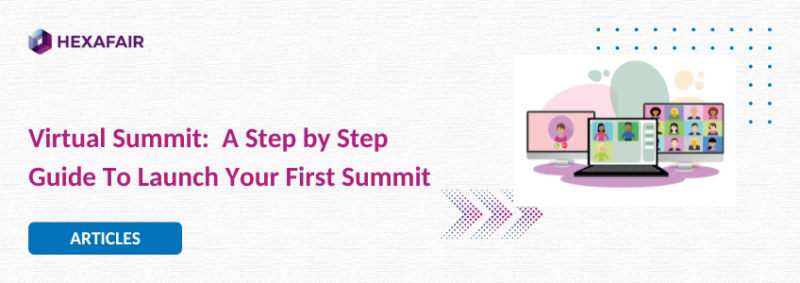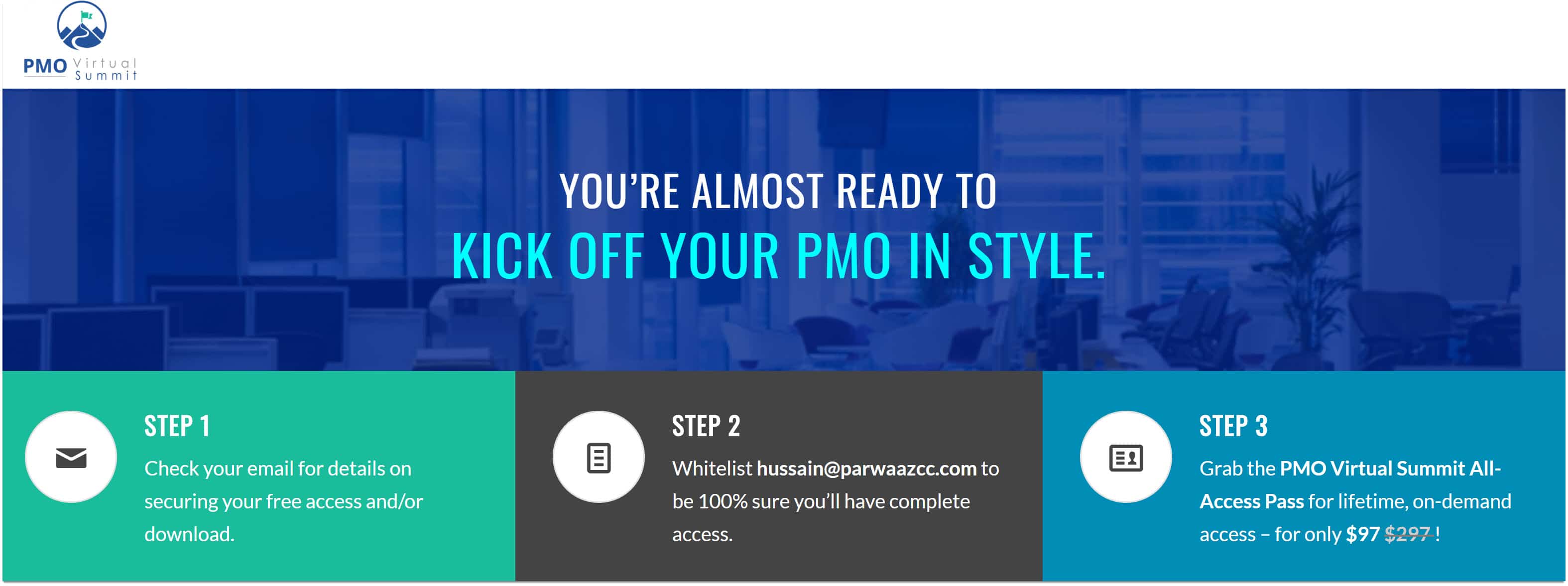Virtual summits are all the rage right now, and for good reason: hosting a summit can be one of the least expensive and quickest ways to generate traffic, leads, and sales for your business, no matter what industry you’re in.
In this blog post, I’m going to show you exactly how to create, host, and launch a successful virtual summit that earns you 5 to 6-figures in less than 30 days.
Here’s what we’re going to cover in today’s deep dive blog post:
- What is a virtual summit?
- Why host a virtual summit?
- How to plan a virtual summit
- How to define your target audience
- How to create the agenda and topics for your summit
- How to create your offer(s)
- How to identify potential speakers for your summit
- How to recruit speakers for your virtual summit
- How to create your summit registration page
- How to create your ‘thank you’ + sales page
- How to create the ‘sessions page’
- How to run your summit, day by day
- Additional Ways to Increase Profit from Your Virtual Summit
Table of Contents
- WHAT IS A VIRTUAL SUMMIT?
- WHY HOST A VIRTUAL SUMMIT?
- WHAT’S IN IT FOR THE SPEAKERS?
- HOW TO PLAN A VIRTUAL SUMMIT
- HOW TO DEFINE YOUR TARGET AUDIENCE
- HOW TO CREATE THE AGENDA AND TOPICS FOR YOUR SUMMIT
- DEFINE YOUR OFFER(S)
- IDENTIFY POTENTIAL SPEAKERS FOR YOUR SUMMIT
- HOW TO RECRUIT SPEAKERS FOR YOUR VIRTUAL SUMMIT
- WHY WOULD A SPEAKER PROMOTE YOUR VIRTUAL SUMMIT?
- HOW TO CREATE AND STRUCTURE THE CRITICAL LANDING PAGES FOR YOUR VIRTUAL SUMMIT
- HOW TO CREATE YOUR SUMMIT REGISTRATION PAGE
- HOW TO CREATE YOUR ‘THANK YOU’ + SALES PAGE
- HOW TO CREATE THE ‘SESSIONS PAGE’
- HOW TO RUN YOUR SUMMIT, DAY BY DAY
- CRAFTING YOUR PRE-SUMMIT EMAIL SEQUENCE
- ADDITIONAL WAYS TO INCREASE PROFIT FROM YOUR VIRTUAL SUMMIT
- #2. OFFER A DOWNSELL
- #3. ADD LIVE SOCIAL PROOF TO YOUR SALES PAGE
- #4. PERSONALIZE KEY PAGES OF YOUR SUMMIT
- PERSONALIZATION IN ACTION
WHAT IS A VIRTUAL SUMMIT?
Let’s start at the beginning:
A virtual summit is a collaborative, online event, that features a series of expert interviews, typically focused on one specific area or niche.
- For example, Teachable hosts a virtual summit every year (which also happens to be their biggest promotional event of the year). Teachable is a SaaS company that allows anyone to create and sell courses online, so naturally, the focus of their summit is on ecourses (how to create them, how to market and sell them, the state of the ecourse industry, etc.).
- Another great example is Lifestyle Entrepreneurs Press. This is a boutique publishing company, and they’ve hosted several summits over the past few years. Most recently, they hosted The Bestseller Summit Online. As you might guess, the focus of this summit is writing and publishing (the type of things that their target market – authors who will sign with them for publishing – would be interested in).
- Or take for example $100k Launch School. The focus of this virtual summit was to highlight some of the biggest product launches in recent memory, across multiple industries and domains, in order to help entrepreneurs, founders, and owners grow their businesses through a launch. I hosted this summit to attract people who are interested in growing their businesses. This helped me rapidly grow my audience and generate interest in my coaching and consulting services (5,000+ new subscribers helped me book out my calendar for the entire year…but more on that later).
These are just a few examples of virtual summits. They work in nearly any niche or industry (I have yet to see a niche or industry where your standard digital marketing strategies work, where a virtual summit would not), and for almost any type of business (B2B, B2C, etc.).
One way to think about a virtual summit is as a hybrid lead magnet + trip-wire.
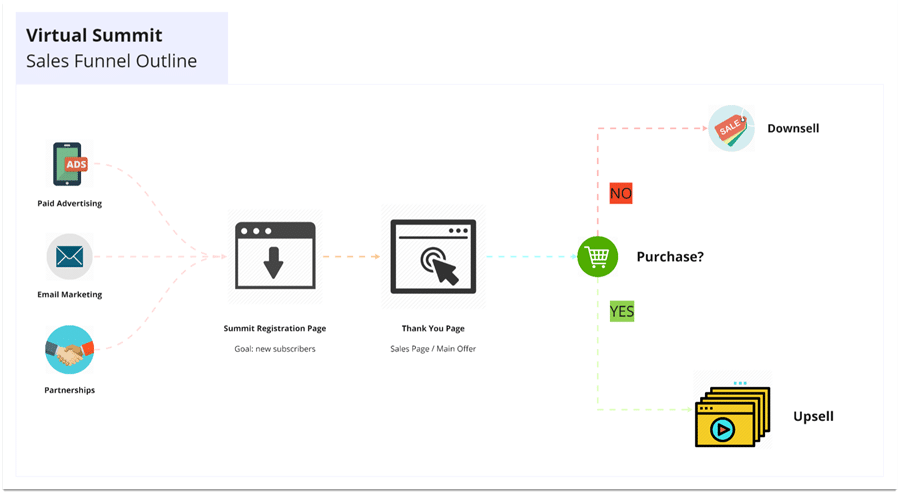
Virtual summits are typically free to attend live (or are free to view during a specified period of time), but require you to pay to access the videos / recordings after the event is over (oftentimes referred to as an “All Access Pass”).
This offer is what makes a virtual summit particularly attractive as a lead generation strategy for entrepreneurs and business owners who are trying to grow their audience from scratch – because you can build your list and make a profit at the same time.
If you’re old school, you’ve probably heard of the term ‘teleseminar’ or ‘telesummit’ – and yes, a virtual summit is basically the same thing, but with a newer, hipper name.
WHY HOST A VIRTUAL SUMMIT?
Since 2015, I’ve worked on, advised, or hosted more than a dozen virtual summits, across a variety of niches: from writing and self-publishing, to networking and management, to marketing, health, and more.
Cumulatively, these events have generated more than a hundred thousand new subscribers, and hundreds of thousands in revenue; easily more than a million in revenue if you count sales of offers on the backend of each of these campaigns (I’ll dissect these upsell and downsell techniques later in this blog to show you how to profit from them).
Not only is it possible for you to host a summit that generates thousands of leads, but if your audience is hungry enough, or you’re in an under-served niche, it’s absolutely possible to break 6-figures from digital ticket sales alone.
I lay out all the primary pros and cons of hosting a virtual summit here:
So clearly, virtual summits are effective for generating traffic, leads, and sales, quickly. And this by itself is probably enough to consider hosting a summit for your business…
But there are a few other reasons you should consider hosting a virtual summit:
Although this is not the reason most people decide to host a virtual summit, I think it’s one of the best:
By hosting a virtual summit, you can position yourself as a person of influence in your niche or industry.
When you act as the ‘impresario’ (h/t Seth Godin) who brings people together, you have a remarkable opportunity to position yourself next to well-known thought leaders and experts. And by facilitating an event that is aimed at helping others, you create a win-win-win opportunity:
- Your audience wins because you’re curating useful and helpful content
- Your speakers wins by reaching a brand new audience
- You win because you helped your speakers and audience win, and you’re right there, front and center, so you get the props
And that’s why hosting an event like this can be so powerful from a personal brand and positioning standpoint: because the influence and authority of your speakers can and will rub off on you.
So instead of being random blogger Z, who writes about the same things random and forgettable bloggers A through Y write about…
…you’re the person who interviewed the most well-respected, well-known, interesting people in your industry – and that sticks.
When I created $100k Launch School, my main objective was to position myself as an expert in the online business “growth” space. I did this by highlighting many of my successful clients as speakers and presenters. For instance, many of the 6-figure launch ‘teardowns’ inside $100k Launch School are past clients of mine and projects I had worked on. This allowed me to not only share and teach something valuable, but subconsciously (or maybe just consciously) demonstrate that I’m more than a host of a summit, I’m someone who knows what it takes to generate 6-figures or more from a launch.
So if you want to grow your influence and authority, a virtual summit can be a game-changer.
Pro tip: if you have successful clients, think about ways you can showcase them and your work together on your summit; it’s an authority amplifier.
Pro tip: if you have successful clients, think about ways you can showcase them and your work together on your summit; it’s an authority amplifier.
#2. GROW YOUR EMAIL LIST
As a business owner who sells online, I’m always looking for the most cost-effective way to reach more people and grow my email list.
Over the past 5+ years, I’ve found that great content (like this blog post ;D) is usually the most effective long-term strategy for generating high-quality, targeted traffic…but the problem is: it takes a while (a few months to a year in some cases) to really reap the rewards of content marketing…
That’s why I love summits.
As of this writing, virtual summits are one of the best ways to generate a massive influx of targeted traffic, quickly.
In order for a summit to be an effective list-building strategy, though, you need to ensure you turn your speakers (or at least many / most of them) into promotional partners (I’ll cover that later on in this guide). If you do this, then the rest is simple:
By focusing your event in a specific niche, you can ensure the traffic coming your way from speakers and promotional partners is exactly the type of audience you want to attract…
And because your summit is high-quality, high-value, and free to attend live, you can turn this hyper targeted traffic into new email subscribers.
Because of this, it’s not uncommon to see a virtual summit result in 5,000 to 10,000 new subscribers in a span of a few weeks.
So if you want to grow your list, consider hosting a virtual summit.
#3. MAKE A PROFIT (FROM SCRATCH)
Another reason I love virtual summits:
It’s a great way to create and sell a digital product from scratch.
The best part: you don’t have to “create” it yourself.
What I mean is: your job is finding the talent (speakers), interviewing them in a way that’s compelling to the listener, and then packaging the content so you can sell it (assuming you’re using the “All Access Pass” sales strategy I write about in this blog post).
That means the majority of the work, in a sense, is on the speakers and not on you.
Note: of course this is a bit of an exaggeration – you will do your share of work to create this…but it’s MUCH less time intensive than creating a course, or designing software, or developing gadgets from scratch)
Plus, you can expand on the core offer (access to the videos / recordings) by including bonuses that your speakers created and willingly contribute to your offer. This could include ebooks, ecourses, or a host of other things.
You can easily double or triple profit by including OTHER PEOPLE’S PRODUCTS inside your “All Access Pass” offer.
In summary: a virtual summit is a great way to go from nothing to a digital product that makes you money, quickly.
WHAT’S IN IT FOR THE SPEAKERS?
So you’re probably wondering:
“But wait Tom – what’s in it for the speakers? It seems like they’re doing all the work, so why would they ever sign up to be a part of something like this? Why Tom, why Tom, why!?!?”
Good question and great Tommy Wiseau impersonation.
Speakers typically care about 1 or 2 things:
#1. SPEAKERS WANT TO GROW THEIR PROFILE AND REACH A NEW AUDIENCE
The single most compelling reason for someone to speak on your virtual summit is to increase their exposure to new audiences as a thought leader in the industry.
A typical speaker will be thrilled to be a part of your summit, especially if you’re in a niche or industry that is underserved (meaning: a hundred other people haven’t asked them to be on a summit already), because it can help position them as the authority they are in the space, and it can help them reach more people.
A virtual summit will give your speakers the chance to share their ideas with a hyper-targeted audience, most likely one they are trying to get in front of on a daily basis. So this is an easy win.
#2. SPEAKERS WANT TO GROW THEIR EMAIL LIST
Beyond exposure, there’s a practical element to being featured on a summit: the chance to grow your email list.
Recently, I was invited to speak on a virtual summit in the publishing space. Here’s what happen when my session went live:
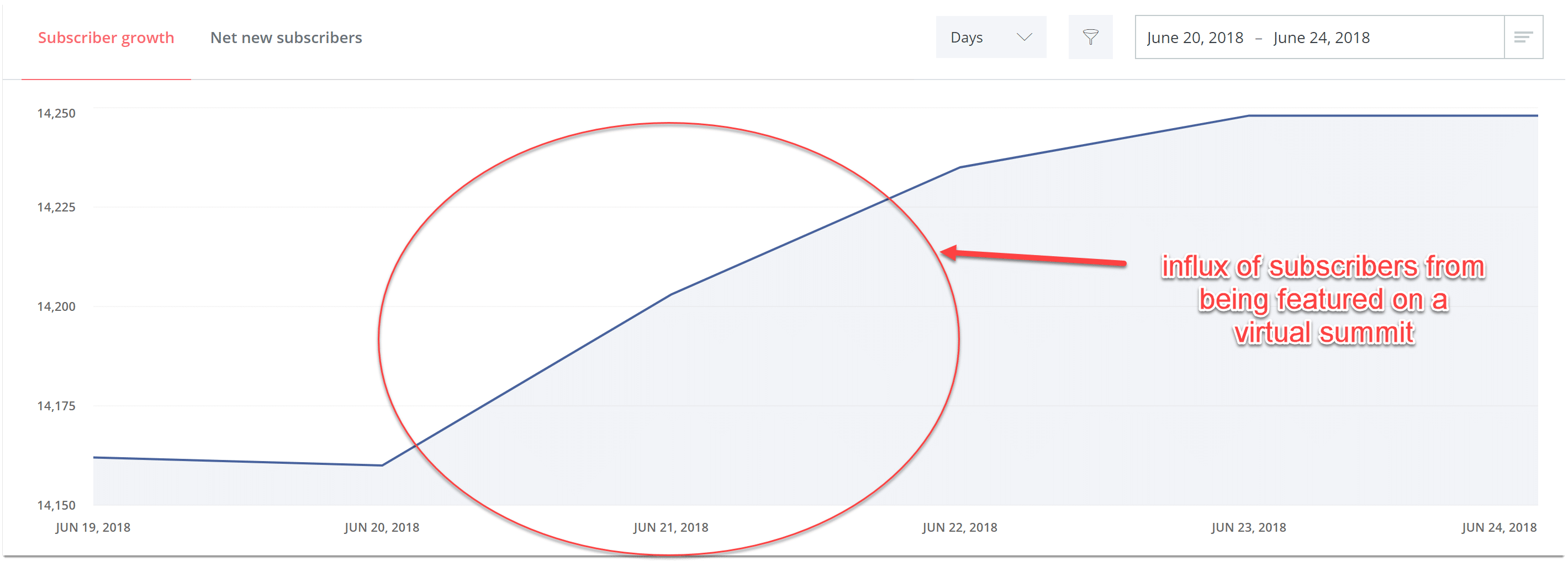
I added over 150 new subscribers to my email list, and all it took was about 1 hour of my time for the interview.
Not too shabby.
In summary, most of your speakers will want to increase their reach and exposure, and/or grow their email list. And you can make a compelling case for both by correctly positioning your request to have them speak (more on that in the next section).
However, there’s one caveat to this rule:
As the ‘status,’ let’s say, of the person you’re inviting to speak increases, the chances of them saying ‘yes’ decreases. In other words, you’re going to have a hard time getting Kanye West to speak on your virtual summit, but you could very well land less famous, though still well-known, thought leaders in your industry.
So don’t get caught up in trying to land some celebrity speaker. It might help, but not as much as you think. Better to focus on recruiting speakers who have smaller but engaged audiences around their ideas. Not only are these type of individuals easier to approach, connect with, and lock down as speakers – they’ll be much more likely to share the event when it goes live.
HOW TO PLAN A VIRTUAL SUMMIT
Virtual summits are simple in theory, but complex in execution. That’s why the difference between virtual summits that generate 6-figures or more, and those that fade into obscurity overnight, begins and ends with planning.
So let’s do it right by starting with the basics:
IMPORTANT: GIVE YOURSELF ENOUGH TIME TO EXECUTE
If you’re hosting your first summit from scratch, and you haven’t started on most (or any) of the items in this complete guide, you need to set the date for your virtual summit at least 4 to 6 months from today.
Why 4 to 6 months?
Because this is the lead time you will need to effectively recruit speakers and to turn them into promotional partners. If you try to expedite this process – and you’re relying on partner traffic for your results – you will fail.
WHY YOU SHOULD NEVER RUSH A VIRTUAL SUMMIT
A few months back, an aspiring online marketer, we’ll call him Joffrey, asked me for advice on his virtual summit. At the time, I had recently helped a coaching client generate 6-figures from a virtual summit. He had heard about the success of the event, and wanted some of Tom’s special made secret launch sauce for his own summit.
When we spoke, he had already interviewed many speakers and was working on the ‘infrastructure’ of the launch (landing pages, sales pages, email sequences, etc.). Based on where he was at, I suggested he set the date for his event about 3 to 4 months in the future. While he had a good start on everything, it was clear to me all the ‘little things’ he still had to do would add up, and as a solopreneur, I wanted him to have the time to do it right. He agreed.
Contrary to my recommendation, he decided to launch his virtual summit within the next 30 days.
In the end, while he was able to launch in 30 days, 90% of his speakers did not promote. Because of the rushed timeline, he didn’t have time to set up a paid traffic campaign, nor prepare his upsell and downsell sequences (all of which contribute to the financial success of a summit).
In the end, he got very little traffic, less leads, and even fewer sales.
I share this story because:
- It’s easy to mess up a virtual summit. The fastest way to fail is by launching too soon or by setting a timeline that is too aggressive.
- Just because you think you can get everything done ‘just in time’ does not mean you should. Even if you’re hurting for cash flow, better to take more time and do it right, then try to speed things up and blow a great opportunity.
So I implore you: don’t be like Joffrey. Do this instead:
- Set a date in the future at least 4 to 6 months out.
- Bookmark this page.
- Follow the strategy outlined in this blog post, step by step.
- Get my bonus ‘Virtual Summit Blueprint’ and USE IT!
You’ll get much better results by taking your time than you will by rushing it, believe me.
HOW TO DEFINE YOUR TARGET AUDIENCE
Okay, so you’re convinced you want to host a virtual summit, and you have the date on the calendar. Good on you. Next, you need to answer two important questions:
QUESTION #1. WHO IS THIS VIRTUAL SUMMIT FOR? WHY DO THEY CARE?
When answering this question, start broad and go deep.
What I mean is start by answering broad, obvious questions:
What niche or industry are you in?
Who do you want to attract within this niche or industry?
Before you say ‘yes’ please note: 90% of people in any niche are probably not interested in buying from you or paying for your services…
So your answer is hopefully more like: ‘I’m looking to attract a smaller subset of people within my niche who will be excited to pay me for my products and services.’
Now go deep:
What do these people want + have in common?
Now ask yourself:
What would you need to provide / what would you need to teach that would make attending this virtual summit worthwhile for your target customer?
This line of questioning will help you develop a useful description of your target audience, and will help you position the virtual summit so it stands out in a way that matters to your target audience.
Pro tip: This is critical. Seriously. If you go too broad or you’re too generic, people will ignore you. So get really clear on this before you move on.
QUESTION #2. WHY DO I WANT TO GET IN FRONT OF THIS AUDIENCE?
When you answer this question, I want you to think past the summit:
What’s the point, for you, if you end up building an email list of 10,000 people who fit the description of the target audience you outlined above?
If you’re using the underpants gnome approach (steal underpants + ? = millions of dollars), then I recommend pressing pause.
Virtual summits are a lot of work (you should be able to tell based on the length of this article). The last thing you want to do is put in all the time and effort to launch a summit, just to find out the audience you built doesn’t help you grow your core business.
So think past the summit…
What happens when you have a captive audience of thousands of people in your niche or industry? What are you going to offer them next? What do you plan to sell? How does this tie into your broader business strategy?
Answer these questions and get as clear as possible – it will make a difference, believe me.
CASE STUDY: TARGET MARKET OF BESTSELLER SUMMIT ONLINE
Jesse Krieger is the founder of Lifestyle Entrepreneurs Press, a boutique publishing company. Jesse hired me to help him generate traffic and leads for his publishing company. We ended up working on two virtual summits together over the course of a year and a half.
While the first summit we worked on was financially successful, it didn’t drive as many new people to publish with Lifestyle Entrepreneurs Press as Jesse was hoping for.
For the second summit, we decided to revisit our target market:
With our first summit, we targeted self-publishers. In hindsight, this was less than optimal. While Jesse provides plenty of resources to help self-publishers, and our virtual summit would likewise be useful for self-publishers, those individuals who consider themselves self-publishers want to do it themselves, and would need to be convinced to publish through someone else. So, self-publishers would not be a great fit…
And we weren’t exactly targeting authors – most people who consider themselves authors are aspiring authors; hoping to someday start or even finish a book. And of those who do finish their manuscript, fewer still want to invest in the business of authorship (and it is, very much, a business). So authors were not the target market…
The question we had to answer:
Who would most benefit from publishing with Lifestyle Entrepreneurs Press? And what describes this group of people (as in, do they share things in common that we can then focus on attracting with our virtual summit)?
After some creative brainstorming, it became clear that the person we wanted to attract to this virtual summit is a business owner or established entrepreneur who wants to increase their authority and elevate their perceived expertise in their industry. This group of people recognize the value of a book as something that can set them apart in their niche, and they’re hungry to leap ahead of their competitors.
Jesse ended up branding this new virtual summit as: “Bestseller Summit Online”
The tagline:
“Leverage Your Ideas, Creativity and Expertise to Create a Book You Can Be Proud of for Years to Come and Positions YOU as the Expert and Authority in Your Field as a Best-Selling Author”
In the end, Jesse increased his email list by close to 10,000 new subscribers. Not only that, but a percentage of these new subscribers were business owners and authors who ended up signing with Lifestyle Entrepreneurs Press – the original goal of the summit.
HOW TO CREATE THE AGENDA AND TOPICS FOR YOUR SUMMIT
I have found that many people, when developing a virtual summit (or similar collaborative event), begin by listing out the speakers they’d like to invite, and then deciding on a topic after the fact.
This is the wrong strategy.
The first thing you should do before outlining your speaker ‘wish list’ is to outline the topics and content you want to cover.
By getting clear on your Target Audience you already have a nice head start to planning the content of your summit.
As you develop your topics, it’s okay to put down names of potential speakers as you go – just don’t do it the other way around. This ensures all your content is as valuable as possible for the person attending your event (and that usually leads to better sales and more profit).
CASE STUDY: PLANNING THE CONTENT FOR $100K LAUNCH SCHOOL
When I was planning $100k Launch School, I started by outlining the type of content I wanted to include in the summit itself. I started with a blank sheet of paper, and wrote down a list of the ideas I thought would be useful to cover.
As I dug deeper, I discovered that there were varying degrees of scope and scale to the topics. For instance, I wanted to ensure entrepreneurs and business owners would understand the prerequisites for a successful launch; the ‘broad brushstrokes’ that will get you 80% of the way there…
But the thing about a ‘launch’ is that the devil is in the details. HOW you ‘launch’ your next product / service / offer depends on a multitude of factors:
- What type of product or service are you offering?
- Is it B2B or B2C (or some hybrid)?
- Do you have an email list?
- How do you get traction on a budget?
- What if you have a big budget – how can you effectively scale?
After I wrote everything down, I went back through and re-organized the ideas to see if I could find patterns or commonality between the ideas.
What I noticed was that there were specific, tactical marketing and sales ideas I wanted to cover that were appropriate to any and all entrepreneurs and business owners. These were things like: email marketing, conversion rate optimization, lead generation, etc. However, for each of these areas, there were particular tactics that would be more useful or less useful depending on the TYPE of offer (e.g. a competent phone sales strategy is perfect for people selling high-ticket service offers, but it’s not relevant for people selling low cost books or courses).
So I organized my content into 4 buckets, based on what you’re trying to sell:
- Book
- Course
- SaaS / membership site
- Service
Next, within each bucket, I outlined specific launch topics I wanted to cover. Here’s what it looked like as I outlined my summit:
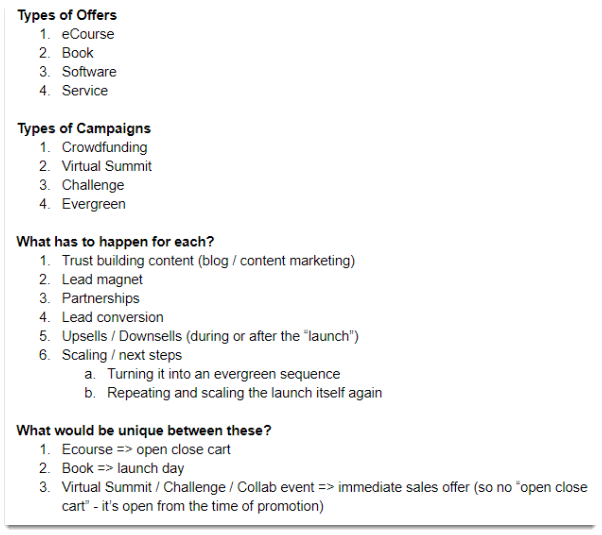
After outlining all the topics I thought would be most helpful to someone trying to grow their business with a launch, I asked myself:
What else would be useful for someone trying to launch a product or service?
Specific strategies and tactics are great, but sometimes people need examples; something they can relate to and follow as a rubric or guideline for their own launch. So the answer was simple: share behind-the-scenes case studies of successful launches.
So within each ‘bucket’ I divided speakers by the TYPE of content and conversation we could have:
- Subject Matter Expert (someone who could speak to a specific strategy, tactic, or technique that would work for any type of launch, or in a specific launch scenario)
- Case Study (in depth conversations with people who have crushed a launch, and how they did it)
From there, I began to fill in the speakers names for each topic.
This type of planning might sound a bit excessive, but I wanted to be able to stand behind the content I was creating. Here are a just a few of the emails I received praising the structure, style, and focus of my virtual summit:
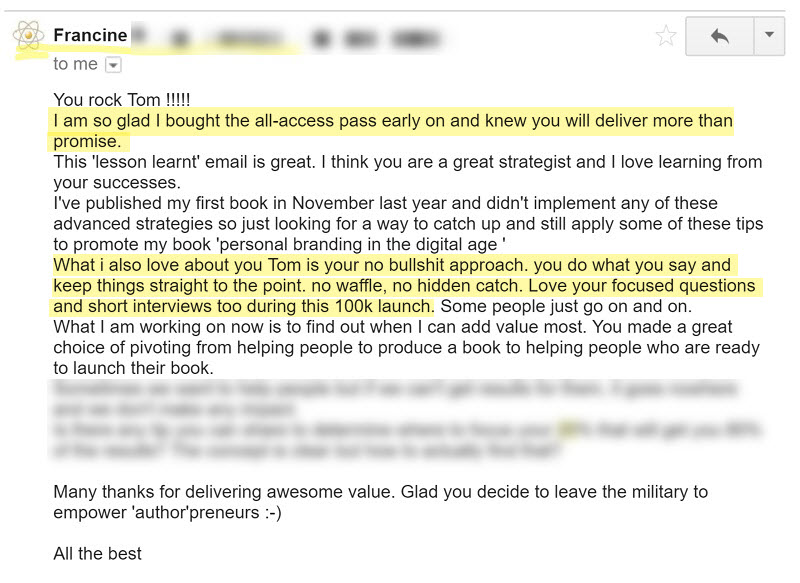

Judging from the feedback I received about the summit, the effort I put into planning was worth it. I encourage all my clients and students to do the same.
Pro tip: no matter what type of summit you want to host, always focus your content on the user experience, and specifically: what will help them get the most outof your event.
DEFINE YOUR OFFER(S)
This is fairly straightforward:
What are you selling?
Another way to ask this question: if everyone who attends your summit buys just ONE THING from you, what would that be?
There are several ways to position a virtual summit to generate sales. When you get specific on this, you can organize your summit (and your offer) to reap the greatest financial profit.
Here are a few of the most common offers, and how you can organize your summit to maximize your profit:
#1. SELL LIFETIME ACCESS TO YOUR SUMMIT
In most industries, your typical virtual summit is free to attend live. But if you want access to all of the recordings so you can watch them anytime you want, you have to pay up.
This is sometimes referred to as an “All Access Pass,” “Lifetime Pass,” or “VIP pass.”
What’s great about this offer is that much of the work has been done for you already by the speakers (as I mentioned earlier). Your job is simply to compile the recordings and host them inside a membership portal area.
You can also sweeten the pot by including bonuses in addition to lifetime access. Here’s an example from $100k Launch School:
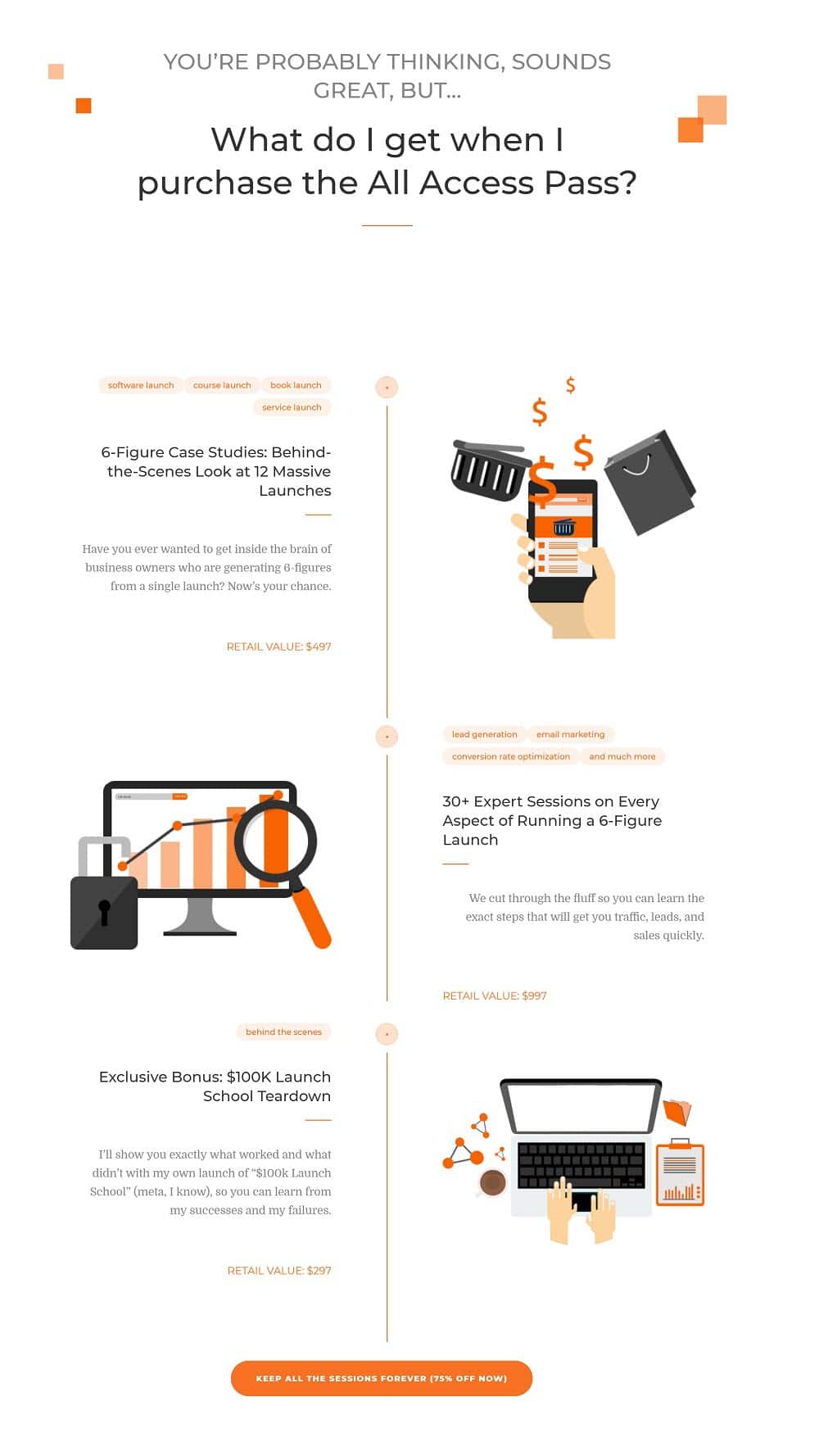
When someone purchases an “All Access Pass” to $100k Launch School, they get all the interviews (a dozen case study teardowns + 30 subject matter expert tutorials for running every aspect of a launch), plus:
- A bonus 2 hour teardown of my launch of $100k Launch School (so people interested who are interested in launching can see how I did what I did for this launch)
- A bonus tutorial on running Facebook Ads for your launch
- A ‘software stack’ breakdown (the exact tools and resources I used to create, market, and sell $100k Launch School)
- A bonus 6-figure case study teardown
As you can see, all of these bonuses add tremendous value to anyone who is planning a launch (my target market).
So when developing bonuses, make sure they are a consistent, logical extension of your “All Access Pass” offer.
As a side note, I added several of these bonuses after the event started. As I engaged with my audience and solicited feedback, it became clear to me what additional bonuses I could include that would increase the value of
“All Access Pass.”
This produced an additional benefit in that it allowed me to introduce and highlight these new bonuses during the course of my campaign, which meant more eyes on my “All Access Pass” offer, which in the end helped me generate $20,000+ in “All Access Pass” sales.
#2. SELL YOUR CORE OFFER AND INCLUDE LIFETIME ACCESS TO YOUR SUMMIT AS A BONUS
This is similar to the method described above, but instead of the “All Access Pass” serving as the core offer, you position it as a bonus accessible only to those who purchase your core offer (which would be a different product or service).
This is a great strategy if you have a relevant offer that has a proven sales record (e.g. the product has been tested and validated in the marketplace, so you know it sells). And it can be especially lucrative strategy if you pair it with something that produces recurring revenue for you and your business, such as a membership site, or SaaS offer.
Each year, Teachable hosts a virtual summit on ecourses (how to create them, how to market and sell them, etc.). For the past two years, these events have helped drive Teachable’s rapid growth.
The way Teachable grew their core business through a summit was simple: during the virtual summit, they sold annual subscriptions to their software with limited time bonuses, including: the “All Access Pass” + additional, exclusive training and resources – but only for those who purchased (or upgraded) during the event.
Bottom line: there are a number of ways to use your virtual summit recordings and bonuses; as a primary or core offer, or as a bonus to increase the value of your core offer (which could be a subscription, membership access, or something else entirely).
IDENTIFY POTENTIAL SPEAKERS FOR YOUR SUMMIT
The foundation of any summit are the speakers. High-quality speakers can attract the right audience, and make an otherwise average summit great…
… but nothing can save a summit with a weak speaker lineup.
So it’s imperative you select the right speakers.
There are three things to consider when choosing speakers.
#1. WHO WOULD PROVIDE GREAT CONTENT FOR MY AUDIENCE?
At this point, You’ve already outlined the content, ideas, and topics you want to cover.
Now ask:
Who can speak on this topic with authority?
Great speakers are often teachers / educators, and/or operators (people who implement these ideas for a living).
If you’re hosting a summit in a niche or industry you understand (and I hope you are), then it shouldn’t take long to think of potential speakers.
If you’re not sure, look for industry experts and notable thought leaders in your space. These are the people who are being featured in industry outlets, and the people who others tend to reference or quote. Another place to look is for competent bloggers and podcasters in your niche. A simple DuckDuckGo search should get you started building your speaker list.
Pro tip: no matter what the answer is to the next two questions, make sure you can answer this question with confidence regarding all your speakers.
#2. WHO HAS BRAND NAME RECOGNITION THAT WOULD LEND CREDIBILITY TO THE EVENT?
The next thing I look for is brand or name recognition.
Will this speaker lend credibility to this event? And will featuring this speaker increase the perceived value of this summit?
It should go without saying a speaker should never decrease the credibility or value of your summit. But what I’m getting at here is that there may be certain individuals whose specific profile will raise the visibility of your event, far beyond anything you could do on your own. These are typically A-list celebrities, and it’s very rare to get them on board without a personal connection or spending a lot of money out of pocket, but it’s something you should consider and strive for securing for your summit.
In most cases, the reason a virtual summit works is because the speakers share the event.
Now, that’s not always the case, there are exceptions to the rule, but for the vast majority of campaigns I’ve run where we’ve hit high 5 and 6-figures from a summit, it’s because the speakers are also promotional partners.
With that in mind, it’s important to select speakers with audiences that fit your target market.
As a general rule of thumb, I like to ensure at least 70% of my speakers fit this description (while simultaneously fitting the description of point number 1 above). That raises the likelihood that I’ll wind up with great speakers who will promote or share, thus increasing the reach of the entire event for everyone involved (including all the other speakers, which makes it a winning strategy).
Now the next question is, how do you get these speakers to say yes?
That’s what we’ll cover next…
HOW TO RECRUIT SPEAKERS FOR YOUR VIRTUAL SUMMIT
Now that you have your criteria for finding ideal speakers, the next step is to build your list of potential speakers and begin your recruiting efforts.
STEP 1. CREATE A “SPEAKER TRACKER”
A “Speaker Tracker” is a way for you to keep track of your outreach efforts. A good tool for beginners is Google Sheets. It’s free and allows you to collaborate with your team, an assistant, or a partner / speaker / affiliate manager.
The Speaker Tracker should include some basic information you’ll want to collect before you start reaching out, including:
- Name
- Outlet / Website URL
- Email Address
- Bio
In addition, I recommend including information pertaining to the state of your ‘outreach’ efforts. This is the ‘tracking’ part of the tracker. I typically like to track the following information:
- Topic (what the person could present on)
- Why is this a good fit for the speaker? (this should be a personalized reason ‘why’ the speaker should speak at your summit)
- Status of Outreach (must email, emailed but unconfirmed, interested, yes / confirmed as a speaker, no)
- Correspondance Notes (I like to keep pertinent information regarding the speaker and the conversations we’ve had here, instead of in other note taking tools or left in the abyss that is the inbox. That way you have a one stop shop for where you’re at currently, and what steps you need to take next.)
Here’s what your Speaker Tracker might look like to begin with:
![]()
This is enough information to get you started, though I usually expand out my Speaker Tracker to include:
- Final topic of the speaker’s presentation
- Description of the presentation
- Date and time presentation goes live
- Tags or other ways to segment that data
You can organize this however you like, though my preference is to add the speakers as ‘rows’ in the database, and the information associated with each speaker as a separate ‘column.’
Personally, I use Airtable, which is like Google Sheets on crack. I love it because I’m a nerd, and also because it’s a really flexible database tool that is easy to use and looks great (I’m a nerd who also values aesthetics). You can sign up for a free Airtable account here.
Here’s what my final Speaker Tracker for $100k Launch School looked like:
![]()
The above is a snapshot of one tab inside my Speaker Tracker, which shows my ‘confirmed’ speakers.
As you can see, I use the Speaker Tracker from start to finish, and also use it as a place to collect every single thing related to the summit, like:
- Headshot Image
- Individual Session Page URL
- Link to the interview when it’s complete
And much more.
I’m not sharing this with you to confuse you, but to give you an idea of how you can organize your speaker outreach, recruitment, and onboarding. And I recommend you commit to using one tool to coordinate and track everything you do regarding speakers. Otherwise, it gets messy really quick.
STEP 2. FILL IN THE SPEAKER TRACKER
I recommend three run throughs for this:
The first run through is Vin Diesel style: fast and furious. Add as many website URLs and names to your tracker as possible. That’s all you want to add to start. For this first run through, don’t worry about how optimal or ideal each speaker is for the summit; rather, get as many names in your tracker as possible, in as little time as possible. Aim for about 2x or 3x the number of speakers you’d like on your summit.
After you compile your list, now conduct a second run through. This is where you should be more deliberate and particular. Look at each website and name you’ve listed, and ask yourself: is this potential speaker a good fit? If no, delete / cross out / remove the name.
If yes, fill in:
- Bio
- Topic
- Why is this a good fit for the speaker?
On your last run through, you should find an email address or point of contact for the potential speaker (worst case: use the person’s ‘contact page’ on their website), and update your correspondence status with the speaker (so you can keep track of where you’re at in your outreach and recruitment process)
STEP 3. SEND AN INDIVIDUAL EMAIL TO EACH SPEAKER TO GAUGE INTEREST
Alright, this next step is critical:
Write a personal email to each potential speaker to see if he or she would like to be a part of your summit.
There are two elements to this first email:
#1. Your first email should be personal
When I say personal, I mean – the email should speak to the individual directly and specifically. It’s okay to use a template, insofar as you PERSONALIZE the email so the person knows this is a genuine request.
This is not the time for cold email, or blanket email blasts. You can save that for selling your SEO services. For recruiting speakers for a summit, it’s imperative you make things personal and specific.
#2. Your first email should be used only to get a reply
You should frame the ‘ask’ of your email so that it can be answered in one of three ways:
- “Yes, I’m interested in hearing more”
- “Maybe, share more info”
- “No thanks”
Notice that none of these answers is a hard “yes I’m in and I’ll promote and we’ll make lots of money together.”
In fact, that response should be an impossibility. Why? Because you want to keep this first email SIMPLE. It should only include enough information to make someone curious to learn more. That’s it.
Once you’ve gauged interest, you can follow up to confirm the details of speaking (and possibly promoting).
Please note: This process might take more time than what you would prefer, but it’s worth it: you should see a 30% – 50% response rate to your emails. And even if many are ‘no thanks’ that’s okay, because you have (hopefully) asked in a non-offensive way. That’s important if you’re playing the long game, and would like to work with this person again in the future.
STEP 4. CONFIRM INTEREST + TURN SPEAKER INTO PROMOTIONAL PARTNER
At this point, someone has expressed interest. Now you want to share more details of the event. Be specific.
To begin with, I recommend you share a one page document about the event that includes the 5 W’s (who, what, where, when, why).
Next, I recommend asking two or three questions, usually along the lines of:
- Is this a good fit for you and would you like to speak on this summit?
- Do you have any preference for your topic or angle on the topic? What can we share that would be useful / potentially lucrative for you?
- Is this something your audience might be interested?
Really, question 3 is what’s critical here. The other two questions are administrative questions: yes, we want the person to speak, and of course we want to highlight them in the most positive light possible.
Question 3, however, is what allows you to gauge whether a speaker would also be willing to promote or share the event.
There’s nuance to this question. There’s a fine line between presenting an opportunity that would be a big win for the speaker and for the speaker’s audience, and soliciting something the speaker doesn’t want. So however you frame it, just make sure you’re genuinely interested in the person speaking regardless if they promote or not.
WHAT HAPPENS IF A SPEAKER DOES NOT REPLY TO YOUR EMAIL?
Recruiting a speaker may take several emails, as well as a pre-interview call to confirm and lock down for your virtual summit.
The process I outlined above is a simplified version of what recruiting looks like. It’s a framework I hope you can use to get started, but please don’t rely on it as the ‘end all / be all’ in terms of recruiting speakers and partners (that’s what my Influencer Marketing Method is for ;D ).
Here’s the deal:
Some people might not respond to your first email. I recommend at least one follow up as a courtesy (it’s a benefit to them if they want to be featured in your summit, after all).
What’s more difficult is that some people, even after they have confirmed interest, or asked for more details, or even confirmed they’ll speak and promote (or one or the other), may simply go silent on you. Even after four or five emails they might not reply…
But sometimes they do.
Having worked on close to one hundred launches (including more than a dozen virtual summits), which have sometimes included hundreds of partners, all I can say is this:
It happens.
And that’s why it’s important to have a sequence of follow up emails ready, or at least a plan in place, to reconnect and re-engage potential speakers and partners.
Something I’ve said for years, and that I try to inculcate in my clients and their businesses, whenever they pursue influencer marketing and affiliate marketing strategies like the one outlined in this blog, is this:
Persistence pays off.
I’ve probably sent hundreds of thousands if not millions of emails to speakers, partners, influencers, and affiliates in the past five years. In fact, according to Contactually (my CRM of choice), I was one of their top 1% of users on their platform in past years (and who knows, maybe I still am!).
But here’s the kicker:
About 70% of these email sends are just to follow up with someone, because they didn’t reply to a previous email.
The key here is:
- Be polite
- Act in good faith
- Personalize your follow up as much as you can
- If someone has given you permission to follow up, then follow up until you can ‘close the loop’ on the conversation
When it comes to follow up email sequences, most of the time you can get a reply after 2 or 3 emails…
However, I’ve received positive – and grateful – replies after my 7th email reminder.
Why?
Because people are BUSY, and a polite reminder, done in good faith, can be a very useful thing for a busy person.
So take all this with a grain of salt, and understand it is nuanced. Be careful and be precise with your follow up strategy.
WHY WOULD A SPEAKER PROMOTE YOUR VIRTUAL SUMMIT?
Just because you get someone to speak at your event doesn’t mean they’ll share the event. If none of your speakers share the event, then you aren’t going to reap the rewards I’ve outlined previously in this blog post. So it’s important you get your speakers (at least some of them) to promote your event.
How do you get a speaker to share the event?
Well, if you have a great relationship, that may be reason enough. But let’s say that’s not enough. There’s one other strategy that seems to work:
Pay them.
There are two ways to pay a speaker for sharing your event:
That would require some negotiation; are you paying them to send an email to their list? How big is the list? What are you expecting in terms of traffic / leads / sales from this person? What else would this get you – social sharing, promoting on some listing site where they have influence, etc.?
This strategy can work, but the downside is pretty clear: you’re net negative from the start. If you pay up front, and the promotion is a dud, then you lost money on this deal. That happens all the time in media and advertising, but if you’re running a bootstrapped operation and you don’t have Ja Rule amounts of cash to throw into your influencer marketing, then here’s another approach:
OPTION #2. PAY YOUR SPEAKERS A COMMISSION ON REFERRED SALES.
Instead of paying your speaker up front to promote, make the speaker an affiliate. Then, for every sale they refer, you split the revenue. The upside is you have no out-of-pocket expense to cover, and all your expenses from affiliate sales are guaranteed to be covered (assuming you’re paying a commission on completed sales, and not something like clicks or optins).
The downside is you pay a LOT more for a sale than you would have if you paid for promotion up front. For example, it’s not uncommon to pay affiliates 30% to 50% per sale they refer (sometimes more). But that’s the trade-off to mitigate your down-side risk, so for many people, it’s a good strategy.
HOW TO CREATE AND STRUCTURE THE CRITICAL LANDING PAGES FOR YOUR VIRTUAL SUMMIT
Below, I’m going to share with you the critical pages of your virtual summit. There are lots of ways to riff on this – dozens of ways to add more points of entry into the summit, and all sorts of ways to customize or change things up – but I’m only going to focus on what you NEED.
Use the following structure as a baseline for your summit, and feel free to use it as a jumping off point.
HOW TO CREATE YOUR SUMMIT REGISTRATION PAGE
The primary “point of entry” for someone to join your virtual summit is the summit registration page.
In its simplest form, a summit registration page is a landing page with an optin form to capture email addresses.
There are three primary elements to a virtual summit registration page:
#1. HEADLINE + “ABOVE THE FOLD” ELEMENTS
When someone lands on your registration page, what is the first thing they see?
Hopefully, it’s an engaging, relevant claim + call to action.
Here are some examples:
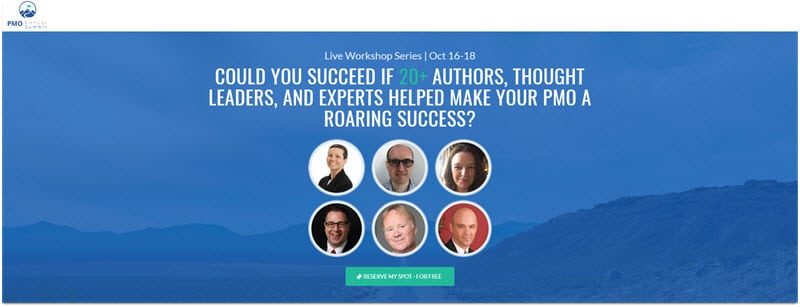
Here’s a simple framework you can use for your virtual summit:
Main Headline: Learn how to [one, two, or three things they will learn] from [number and classification / status of speakers]
Subheadline: Dates and times of the event
CTA: Click Here to Claim Your Free Ticket
#2. MAIN PAGE CONTENT
Consider fleshing out your registration page by including a few additional sections. I recommend the following:
SECTION 1. ABOUT THE EVENT
This is a broad overview of the summit. What is it and why does it matter – in two paragraphs or less.
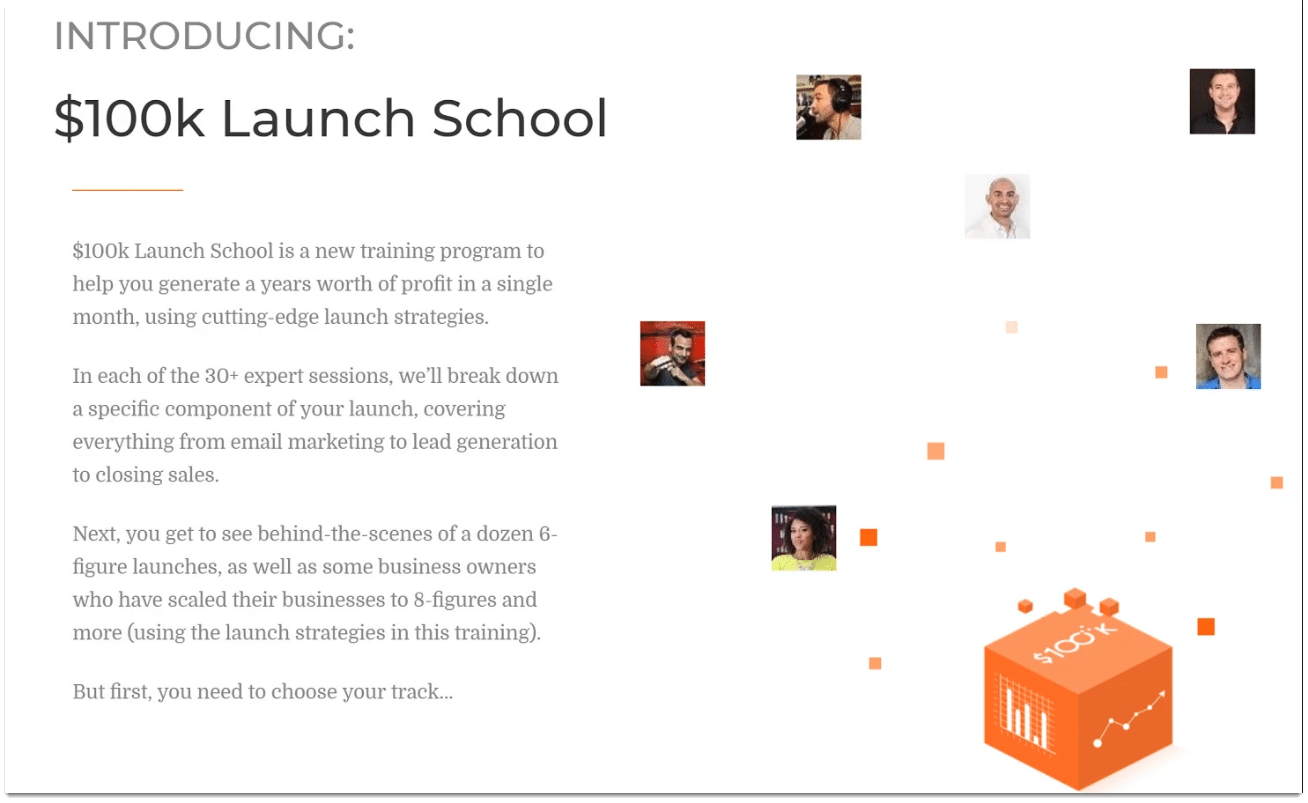
SECTION 2. WHY YOU SHOULD JOIN
Here, you need to answer the questions:
Why should I sign up for this virtual summit? In a world drowning in content, what makes this event stand out? Why should I drop everything to signup and to attend the sessions?
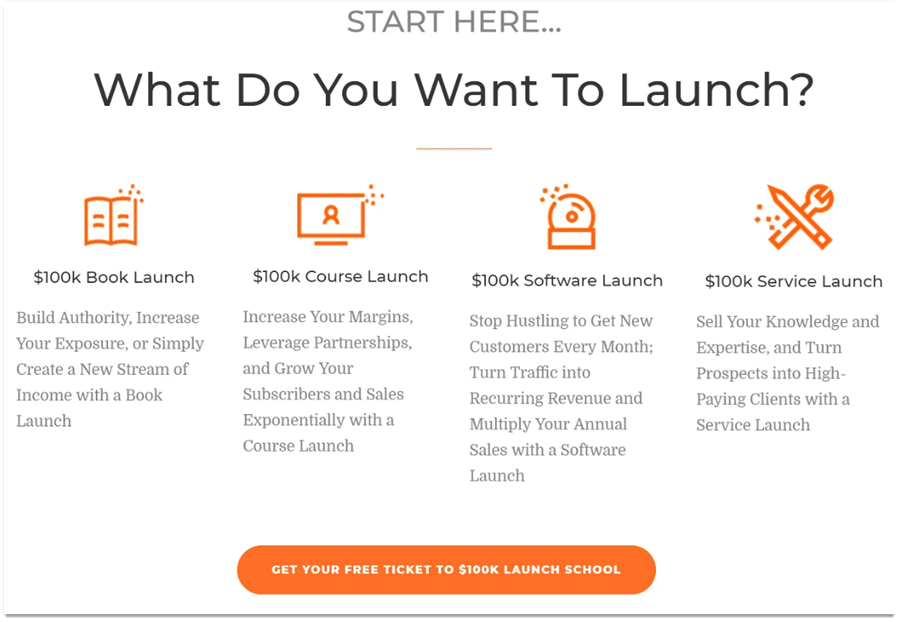
SECTION 3. WHAT YOU WILL LEARN
Include the main benefits from attending the summit. This can be in paragraph or bullet format. This is a great place to expand on some of the ideas you’ve already mentioned in the above sections.
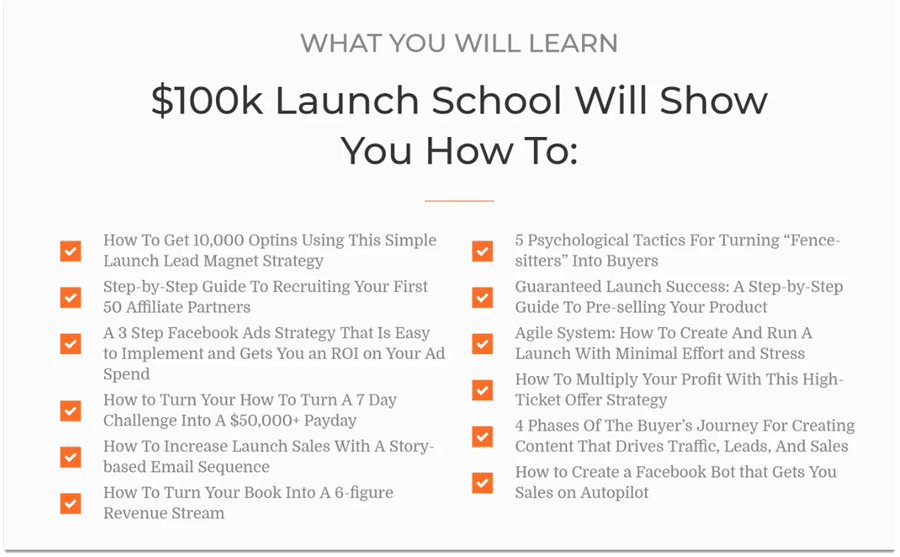
SECTION 3. WHAT YOU WILL LEARN
Include the main benefits from attending the summit. This can be in paragraph or bullet format. This is a great place to expand on some of the ideas you’ve already mentioned in the above sections.
HOW TO CREATE YOUR ‘THANK YOU’ + SALES PAGE
Once someone registers for your virtual summit, they should land on a ‘thank you’ page.
If you want to increase sales of your core offer, this ‘thank you’ page should include the offer, any bonuses you’re including, and a countdown to when the offer expires.
For instance, if you’re selling an “All Access Pass” as your core offer, your sales pitch for that should be on the ‘thank you’ page (complete with any bonuses, extra features, testimonials, discount, refund policy, guarantee, and more).
Or, let’s say you’re including lifetime access to all of the interviews / sessions when someone upgrades to your annual membership (software, community, whatever), then your sales pitch should be for your annual membership, and should explain how you can get access to all the recordings as a BONUS for purchasing or upgrading.
What you’re selling will dictate how you set this page up. So for now, some basics:
#1. INCLUDE A NATURAL SEGUE FROM REGISTRATION PAGE TO YOUR OFFER
At the top of your sales page, you should include a sentence (or two) thanking the person for signing up, and letting them know two things:
- That they should check their email for the free ticket to the summit…
- That they should take a minute to review this incredible offer you have available for them today, right here, right now, on this very page…
If someone signs up for a free event, and then they’re greeted with a sales pitch, it might be a little discombobulating. And it can often lead to frustration on the end of the user who just signed up for the free ticket…
Avoid that scenario by including some simple message to let them know what they just signed up for + how to get it (“check your email…”), as well as the special offer available to them on this page (“but first, you don’t want to miss this opportunity…”).
Here’s a great example from Hussain Bandukwala’s “PMO Virtual Summit
#2. INCLUDE BONUSES
In some industries, selling your interview recordings is enough to generate a substantial profit.
A client recently ran a campaign in an underserved niche, something you might not expect to have a significant audience (unless you’re part of it), and she sold $100,000+ worth of All Access Passes. She included the interviews and transcriptions in that offer. That’s it.
However, in more competitive marketplaces (marketing, business, publishing, self-help, etc), you’re less likely to hit those numbers without something extra.
That’s where bonuses come in.
Not sure what to include a bonus?
Here are a few ideas to get you started:
- Additional interviews or sessions, exclusive to All Access Pass holders
- Templates, swipe file, or additional resources
- Bonus live group training (or series of training)
- A physical book or journal
You can even include bonuses from your speakers!
Here’s an example of Tina Van Leuven’s “All Access Pass” offer for her virtual challenge (like a virtual summit, but a bit different…I may do a blog post on this in the future. Leave a comment if you’d like me to!):

#3. INCLUDE REAL URGENCY
Nothing gets people to take action like real urgency. The simplest way to increase urgency is with a countdown timer. There’s just something about a countdown timer, quietly ticking away to zero, that makes people pay attention and really consider what they’re looking at.
There are a few ways to incorporate countdown timers on your site:
Option #1. Add a countdown timer that shows when the price of your “All Access Pass” (or core offer) will increase in price.
Option #2. Add a countdown timer that shows when the offer will expire.
Option #3. Create and deploy an evergreen, dynamic timer that gives first time visitors X number of minutes to purchase before the offer / deal expires.
Software like Motionmailapp.com and Deadlinefunnel.com make implementing really easy.
HOW TO CREATE THE ‘SESSIONS PAGE’
A session page is where you’ll publish individual interviews with your summit speakers. It’s typically a stand alone landing page that includes:
- The interview video / live stream
- A Call to Action to upgrade (to the “All Access pass” or core offer)
- Optional: chat or question area for viewers
Personally, I combined content from my sales page directly into my ‘sessions page’ template. And then I just swapped out the videos and update the URL for each of my individual speaker sessions / interviews.
Here’s what it looks like:

You can simplify this page by only including the video + a CTA that directs people to the sales page itself. That will reduce the complexity of this page. It’s impossible to tell which is higher converting as I haven’t found a good way to split test this, so consider this layout (video + core offer on same page) a matter of preference.
HOW TO RUN YOUR SUMMIT, DAY BY DAY
Alright, so at this point, you’ve got your topic selected, your speakers recruited, and your pages setup. Now it’s time to kick things off and actually run the summit.
A summit can be broken down into three phases:
- Phase 1: pre-summit
- Phase 2: live event
- Phase 3: post-summit
Let’s examine each phase in-depth:
PHASE 1: PRE-SUMMIT
During the pre-summit phase, you want two things to happen:
- Traffic turns into new subscribers
- New subscribers purchase your “All Access Pass” (or core offer)
The nice part about a virtual summit: if you can accomplish #1 above, #2 will follow as a result. So your time and energy should be spent on doing whatever it takes to get new subscribers.
Since you already have your landing page read, that means you just need one thing: traffic.
PUSHING TRAFFIC TO YOUR SUMMIT
There are lots of ways to convince people to attend your summit.
- If you have an email list already, tap into that…
- If you’re big on Instabook, or Facechat, or whatever social media platform is currently hypnotising millennials, tap into that…
- If you’ve got a budget, you can run ads everywhere…
Pretty much all your standard traffic-generation strategies will work for a virtual summit like they will for anything else (except for the obvious, longer-fuze strategies like SEO).
But the best source of traffic will be from your speakers.
Earlier in this ebook-like-blog-post, I wrote about recruiting speakers and creating a compelling reason for them to share and promote the summit when it’s live. So I won’t belabor that point.
But just because someone said they would share doesn’t mean they WILL share.
And it’s not because he’s a bad person, or because she hates you all of a sudden, or because they decided that now, when the campaign is underway, that they don’t want to be associated with you…
No, the reason your partners won’t promote is because:
- They’re busy
- You’re making things difficult
That’s it.
3 TIPS ON GETTING PARTNERS TO PROMOTE
So the question is: how can you ensure someone who is very busy is able to promote and share your summit?
Here are some tips to get you started:
TIP #1. SERVE YOUR PARTNERS LIKE ROYALTY
It helps to communicate with each of your partners if you think of him or her as if they’re the laziest person on the planet with less than 3 minute attention span.
Let’s start with the obvious: no, they’re not lazy, and yes, they have a longer attention span than 3 minutes.
The reason you should still pretend this is the case is because it will force you to think through how you can make promoting your virtual summit as easiest, simple, and frictionless as possible.
For example: the laziest person on the planet doesn’t want to have to create a new account on some random platform so that they now have to remember another password, login to that account, navigate it’s terrible UX/UI, try to make heads or tails of what is the right link to use, and decide on the correct swipe copy to share – just to send an email.
No, the laziest person on the planet would rather have that all done for them so they have to do nothing.
Or short of that, this person would prefer to be given exactly what they need, when they need it, so all they have to do is copy, paste, and send.
If you want them to send an email, give them the EXACT email they need to send with their affiliate links already integrated, and make sure it’s within the body of the email you send their way (assuming you’re using email to communicate, which is probably a good idea for this). That way all they need to do is open an email, copy and paste what you gave them, and click send.
Three steps instead of 30.
That’s much easier, much simpler, and about as frictionless as possible (short of sending the email for them).
Bottom line: don’t make your speakers and affiliates jump through hoops. Give them everything they need, ready to go, neatly and on time (with lots of reminders for good measure).
TIP #2. FOLLOW UP (FOLLOW UP, FOLLOW UP)
If it’s one universal lesson I’ve learned in life, it’s this:
Persistence pays off.
When it comes to getting speakers to promote and share your summit, same rules apply.
Just because someone agreed to share your summit 6 months ago doesn’t mean you’re good to go. You need to follow up; probably at least once a month in the lead up to the summit, and every week in the month before a summit. Then you need to follow up every few days during the summit (during the pre-summit and live-event phases at least).
If you don’t understand why this is needed, refer to Tip #1 above.
TIP #3. GO OLDSCHOOL
A lot of people who come to me asking for advice and help tend toward the more shy and insecure. Usually, this is a result of being new in the space. That’s forgivable.
What’s not forgivable is pretending that a single email will get everything done for you the way you want.
If you’re not getting a reply from a partner, here’s an idea: shoot them a text. Or better yet: call them on the phone.
These oldschool modes of communication are awesome because nobody does this anymore. You’ll be surprised how quick you get a reply when you shoot a text, leave a voice message, send a text message, and follow up with one (or more) emails.
CRAFTING YOUR PRE-SUMMIT EMAIL SEQUENCE
Once people begin to land on your registration page and sign up for your summit…then what?
Well, because you made your ‘thank you’ page a sales page, you should see sales begin to roll in. That will be a great feeling when you start seeing it happen, believe me :).
However, if this is all you do, you’re going to miss out on more than 50% of your sales.
The thing that will actually sell your core offer (“All Access Pass” or otherwise) are emails sent directly to the new subscriber. So you’re going to have to craft a sequence of emails that compel your new subscribers to but what you’re selling.
Here’s what I recommend as a *rough* outline of the emails you should send and when:
- “Thanks for signing up” email. Thanks for signing up (with a pitch for your “All Access Pass” or core offer in the ‘p.s.’ area). This should be sent immediately after someone registers for your summit.
- “What it’s all about” email. What the summit is all about (this is a teaser for the event with a CTA for the “All Access Pass”).
- “The highlight” email. Highlight the most important aspect of your offer (this is a direct sales pitch for your “All Access Pass” or core offer).
- “Tomorrow this deal is gone” email. Tomorrow, this deal goes away! (This is sent the day prior to you raising the price of the “All Access Pass”, and/or removing bonuses that are exclusive for early adopters – aka: people who buy now, not later)
- “Few hours left” email. Only a few hours left! (This is also sent the day prior to a price increase or product change – and should be sent out 6 to 12 hours before the offer expires)
- “Serioiusly last chance” email. Last chance! (yup, 3 emails on the same day. This is the last and final warning, and should be emailed a few hours before the offer expires).
If you think this email sequence, specifically the 3 emails before a price increase or change to the offer occurs, is too aggressive…well, do what you will. But here’s the effect of this kind of email sequence:
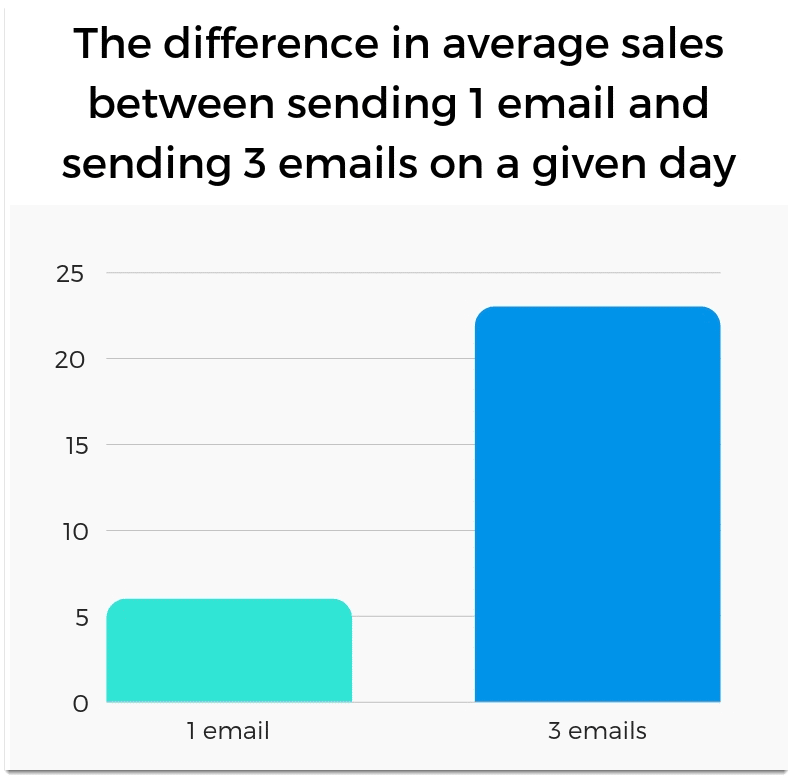
In other words, based on the stats from numerous campaigns, you could increase sales by over 300% if you’re willing to send 3 emails the day before an offer expires.
This could be in the form of the offer going away forever, or a price increase, or a removal of a special bonus – whatever it is, if there’s genuine scarcity involved, sending more emails the day before a change like this occurs will result in more sales.
CASE STUDY: WOMEN IN PUBLISHING SUMMIT WITH ALEXA BIGWARFE
Alexa Bigwarfe is the founder of WritePublishSell.co, Kat Biggie Press, a book publishing imprint, and creator of the “Women in Publishing Summit.”
I began working with Alexa after she had already attempted not one but two virtual summits – both duds. This was, in many ways, the last chance she had to pick things back up in her business. So we got to work…
Alexa spent several months implementing the strategies we developed together. But when things kicked off, she got nervous. Sales weren’t where she was hoping they would be and she wasn’t sure what to do. So I reminded her to stay the course and focus on what we’d already discussed. I also encouraged her to be more aggressive with her emailing – which only made her more nervous – but to her credit she made the leap and trusted the process.
In the end, she generated over $20,000 in sales during her virtual summit campaign. The majority of sales came as a direct result of the email tactics I’m sharing with you right now.
Here’s the email she wrote to me after sending 3 emails in one day for the first time ever:
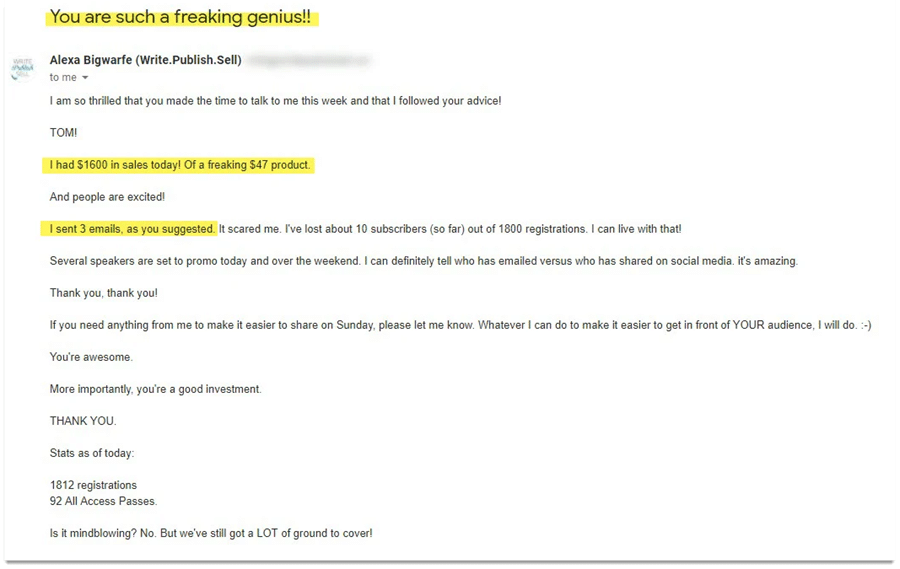
BONUS: I recently recorded a special interview with Alexa on "In The Trenches." Click here to go behind-the-scenes of Alexa's virtual summit launch that generated over $20,000.
PHASE 2: LIVE EVENT
The live event is probably the most straight-forward part of the virtual summit campaign. This is the time when your videos are made available for viewing (or when you showcase your live interviews).
The same traffic-generation rules apply here as they did to the pre-summit phase, so I won’t belabor the point.
As for the email sequence, this is also fairly simple:
Send one to two emails each day highlighting the various speakers or interviews that are live. I recommend including a link to individual session pages.
And of course, don’t forget to add a ‘p.s.’ with a CTA to purchase your core offer.
Here’s an example of what an email during the summit could look like:
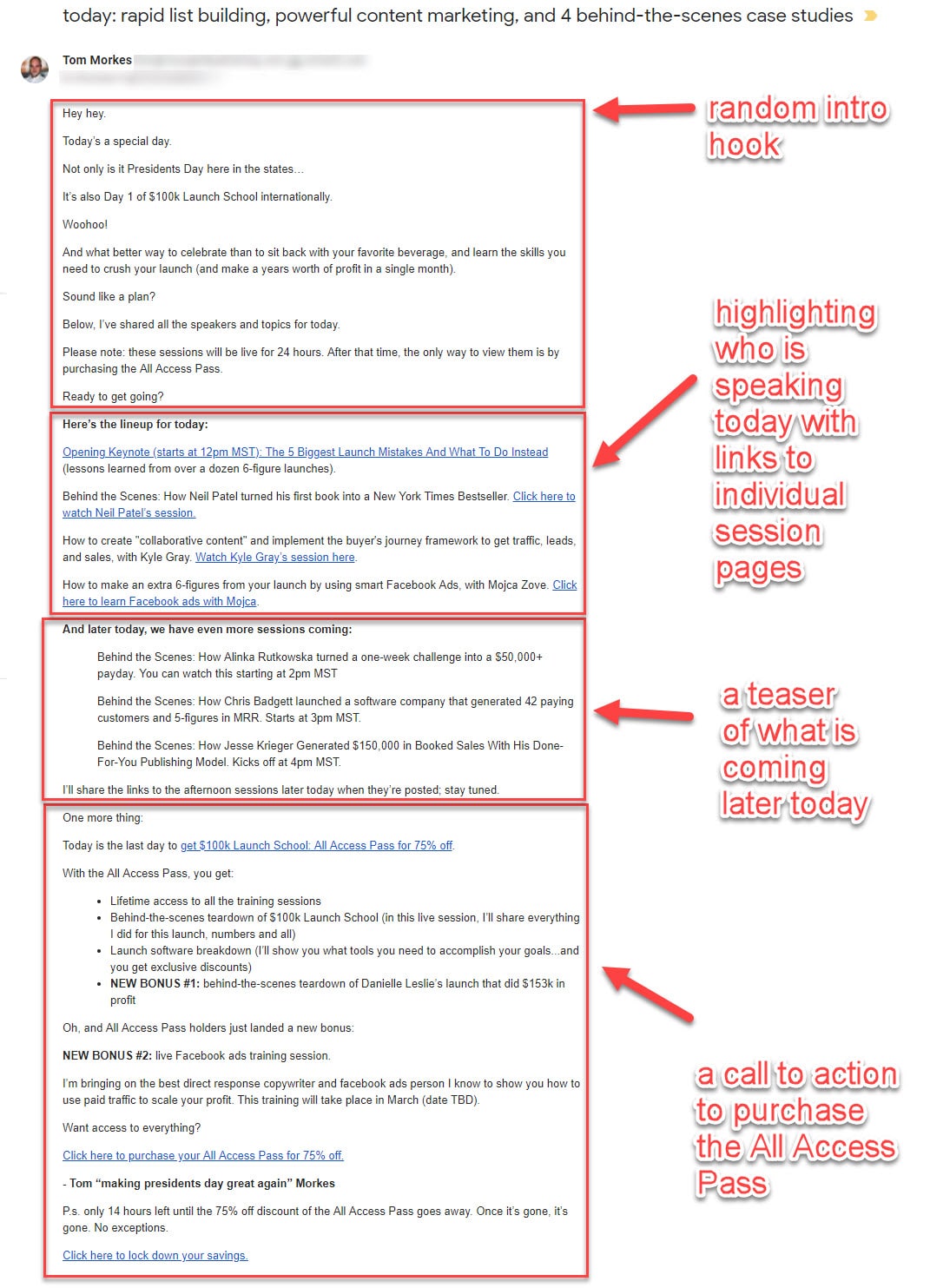
PHASE 3: POST-SUMMIT
Too many people make the mistake of thinking a virtual summit is the event, campaign, or promotion. It’s not (or at least it shouldn’t be).
What comes immediately AFTER your summit is what really matter.
This is your chance to turn virtual summit visitors into loyal customers, clients, and fans.
You can do that a number of ways:
- If you’re a coach, you can offer a high-ticket coaching offer.
- Sell digital products like ecourses, infoproducts, etc.? Make an offer for your flagship (aka, most expensive and relevant) course.
- Running a membership site or SaaS company? Give people a ‘no-brainer’ reason to sign up for a year of access.
All of this can be done on the backend of a virtual summit.
The reason this is so important: you have direct access to a new audience of viewers and subscribers, many of them have been paying attention to what you’re doing and are interested in working with you in a deeper capacity.
If you flake on making an offer for your flagship course, product, service – whatever – after your summit comes to an end, you just wasted a ton of time, money, and energy.
Sure, you could have run a profitable summit, maybe even reaching 6-figures…but you missed out on the MAJORITY of your profit.
With the right post-summit sequence, you should be able to multiply your profit by 5x to 10x in the months following a campaign. True story.
Take, for example, Jesse Krieger who hosted The Bestseller Summit Online. After his profitable summit, he ran an email sequence for a live event that led to over 6-figures in new sales.
After my summit, I added another 6-figures to my bottom line from coaching offers alone.
Or consider some of the SaaS examples I shared in this blog post. The residual effect of the summits they ran added tremendous growth in terms of new, paying customers. I can’t share specifics, but suffice it to say it’s not trivial.
BONUS: You can learn exactly how people like Jesse Krieger and others generated 5 to 6-figures from their launches inside $100k Launch School. Click here to learn more.
ADDITIONAL WAYS TO INCREASE PROFIT FROM YOUR VIRTUAL SUMMIT
Okay, so, at this point, we’ve covered the fundamentals of running a virtual summit. With just what you see here, there’s a good chance you could crush your virtual summit and make 6-figures or more like many of my clients.
But, there are a few more things you can throw into the mix that will make your virtual summit even more profitable.
I’ll share those below:
#1. OFFER AN UPSELL
What happens immediately after someone buys your initial offer (All Access Pass or otherwise)?
If the answer is nothing, you’re missing out on a significant portion of your revenue.
For example, I recently bought sports coat from an online men’s retailer. After I completed my purchase, I was presented with a landing page that said “Thanks for your purchase!”
Wonderful, I thought, I’m good to go…
But then I remembered I forgot to buy flashy handkerchiefs to match my dress shirt. I had to dig back through the website to find them. Thing is, once I found them, I decided to just buy them on Amazon from another competitor because the checkout process is so much easier.
LESSON LEARNED:
Besides the lack of a one-click purchase option the second go round, the other item that was noticeably absent: I was never offered anything after I completed the purchase.
This is a mistake that tons of websites get wrong.
Here’s the deal: the best best time to make an offer is immediately after someone has already made their purchase. Why? Because the customer is already in the ‘buyer’s mindset’ – and so making the case for an additional purchase is much, MUCH easier. When you combine that with an offer that IMPROVES upon the original purchase, you have a win-win scenario. What’s more, generating a sale from an existing customer is less expensive, easier, and more profitable than trying to generate one new customer sale.
In my case, a set of flashy handkerchiefs, a pair of super-sexy cufflinks, or a baller-style tie clip would have been appropriate – and I probably would have bought all three. Alas, I did not (from this retailer, at least).
The value of an upsell is just as true for your virtual summit. Once someone has purchased access to your content, now is the optimal time to present a complimentary offer.
So what are appropriate upsell opportunities for a summit?
UPSELL OPPORTUNITY #1. TRANSCRIPTS
Easy to read transcripts can be time intensive and expensive to create (especially when you need to transcribe 20+ hours of content). Further, while many people won’t be interested in transcripts, you’ll always find a portion of your audience that would prefer to read than watch a video.
So if you don’t think to include transcripts, I can’t blame you…But I wouldn’t recommend that because a small portion of your audience will really want the transcripts.
So why not include profession transcriptions as an additional offer?
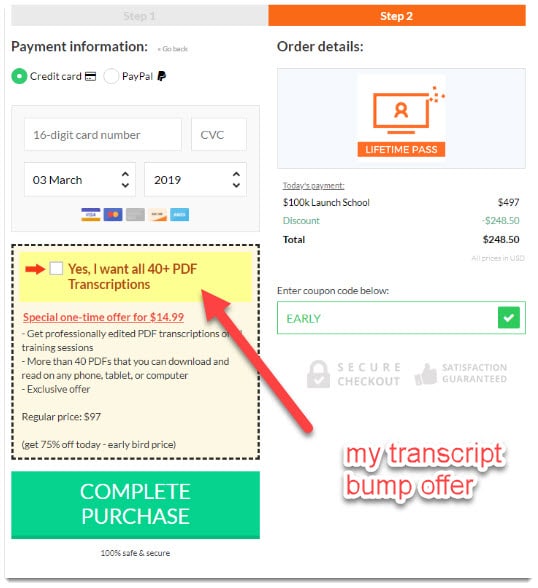
I offered professional transcripts for all 40+ $100k Launch School sessions as a bump offer during the checkout process (so slightly different than what you typically see as an ‘upsell’ offer). So someone could check a box to add transcripts to their order for a marginal increase in price before completing the purchase. This helped me generate an extra $1,469.87, which more than paid for the transcriptions themselves.
UPSELL OPPORTUNITY #2. COACHING OR CONSULTING
Offering coaching, or a relevant done-for-you service, is a great way to boost overall profit from a summit. This person is clearly interested in learning topic X, so what if you could help them IMPLEMENT topic X? Or better yet, do it for them?
Additional coaching or implementation is an easy way to dramatically increase your overall revenue and profit from a summit, so don’t shy away from making this offer (and even if you’re not a coach, you could always outsource something like this – there are hundreds of potential coaches, freelancers, and agencies who would be really happy to take this offer your hands for the right split of proceeds).
After I completed the $100k Launch School live event, I segued into promoting my high end coaching program: $100k Academy. This campaign lasted about three weeks and allowed me to triple my launch revenue (which does not include sales generated as an indirect result of the summit, such as sales of my other courses, new client inquiries, and more). So while not a typical upsell offer presented immediately following the sale, it served the same purpose.
UPSELL OPPORTUNITY #3. COURSE OR INFOPRODUCT
I would say this is probably the most difficult offer you could make – and most likely deserves a complete email sequence to truly sell – but it’s still an option so I’ll share it here. Courses and infoproducts can be extremely lucrative. The challenge is that a virtual summit is already a lot of information…so selling more information after someone has bought an information product from you is a bit of a tough sell.
If you go this route, make sure to clearly distinguish between your “All Access Pass” and this new course offer. For example, if you’re hosting a summit on woodworking, an appropriate course offer might be something that walks the person, step-by-step, through creating their first table or bookcase or chair or whatever. Basically, anything that drills down deeper into your topic, or that provides a much more comprehensive experience, is a good potential fit.
#2. OFFER A DOWNSELL
Like the upsell described above, a downsell is another opportunity to generate additional revenue, but this time from those who did not purchase your initial offer.
I typically see a 10 – 20% increase in revenue by offering a downsell to those who don’t purchase my initial offer.
Let’s say your initial offer is an “All Access Pass” (with whatever bonuses you’ve included to spice things up). Those who purchase get your upsell offer…
But what about those who don’t purchase? In a given campaign, that’s likely to be upwards of 90%+ of your email list (true story). So in any given launch, the vast majority of people will never see your offer…
…and the vast majority of those who DO see your offer still won’t buy.
That’s not good, right? Well, here’s what you can do to nudge a few people from ‘just looking around’ to happy customer.
OPTION 1. OFFER A PAYMENT PLAN FOR YOUR CORE OFFER
For instance, if you’re selling your “All Access Pass” for $197 during the summit, you could present a ‘flash payment plan offer” at the end of your summit, where someone can get access for only $27 / month for 8 months (or $47 for 4 months; or $77 for 3 months…you get the idea).
My clients have seen anywhere from a 5% to a 15% bump in overall sales and revenue when we implement this strategy.
The best part is it’s simple and you can execute with minimal effort. All you have to do is create a special checkout cart or coupon code for the payment plan offer, and write one or two emails around this limited-time payment plan offer, then click send. Boom – big boost in revenue (and profit) for very little work on your part.
OPTION 2. OFFER A RELEVANT BUT LESS EXPENSIVE PRODUCT
Let’s say your virtual summit topic is restoring Ford Bronco’s for profit.
After you’ve made multiple offers, appealed to scarcity and urgency, and stacked your bonuses – there are still readers / viewers / subscribers who have NOT purchased your “All Access Pass” (for shame).
Perhaps this person is not interested in all the great interviews you’ve conducted, but he’d still like to get started working on his Bronco…well why not offer him a ‘starters guide’ ebook on the subject? Something you could sell for under $19 or $29 (one time only, flash discount offer)?
Something like this is sure to sell (to at least a portion of your audience).
Now, this offer doesn’t have to be an ebook. The point here is it should be less expensive to purchase than the initial or core offer you originally made. In addition, the best downsell offer is something that would help out the beginner just getting started (as that’s the person who is most likely interested, but doesn’t have the money to invest in your original offer – or at least he hasn’t been convinced to spend it yet).
Nothing gets people to buy like seeing other people buy things first.
There’s a whole field of psychology about this (or at least a lot of literature on the subject), so I’ll spare you the details:
Bottom line: if you can show people how people like them are buying product X, they are more likely to buy product X. Just look at any Apple iPhone launch from the past decade for reference; the people who have it have it day 1 inspire others to have it day 1 (or shortly thereafter)
So how do we recreate this for your summit?
Simple, install something like FOMO or UseProof to highlight recent subscribers or purchases.
Here’s what it would look like live (see my beautiful GIF below):
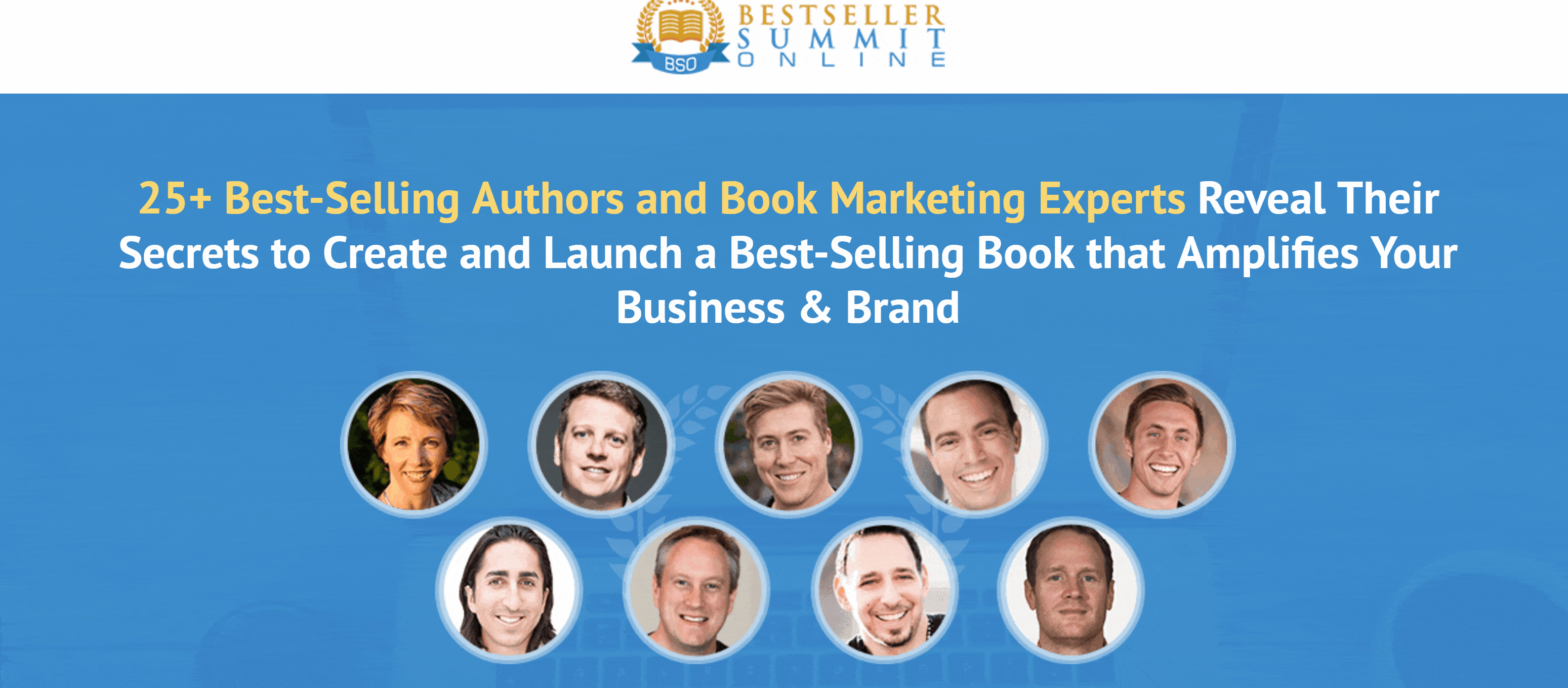
And here’s what happened when we used this for Jesse Krieger’s “Bestseller Summit Online” summit:
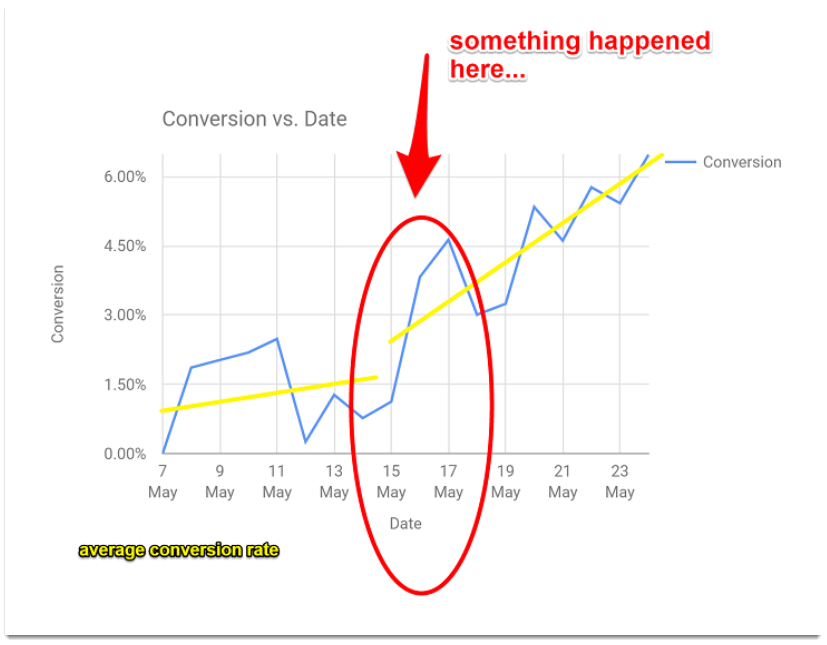
Can you guess what happened around the 15th? Yeah, you guessed it – we turned on FOMO notifications.
And here are our day-to-day conversion stats after we turned on the notifications:
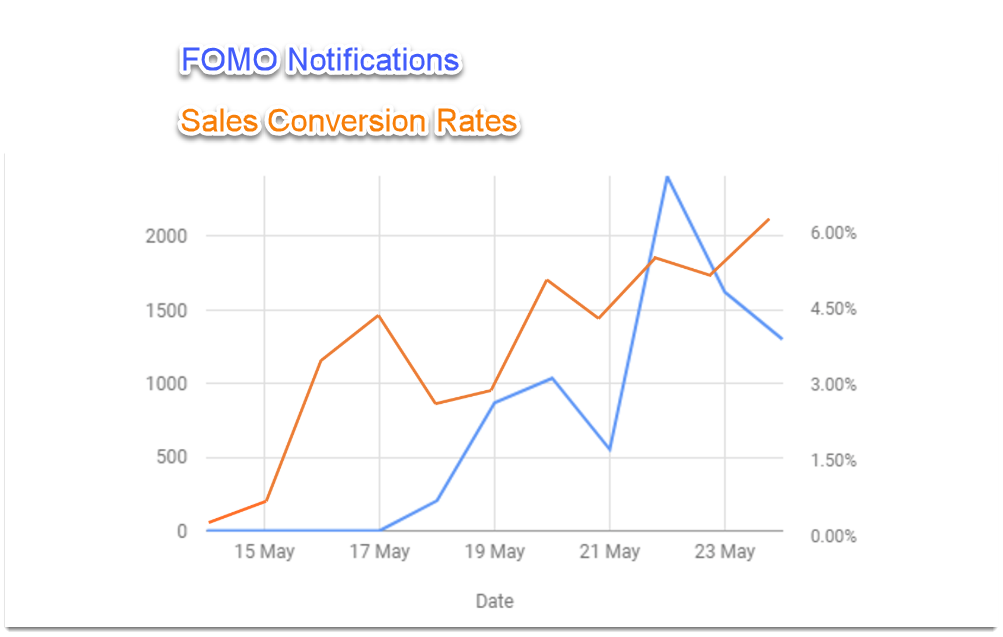
Bottom line: this takes only a few minutes to setup and should help dramatically increase your sales overall.
Plus, the guys over at FOMO are super helpful setting everything up, so I highly recommend pulling the trigger on this for your next event.
#4. PERSONALIZE KEY PAGES OF YOUR SUMMIT
This topic is somewhat complex and deserves its own blog post to do it justice, so I won’t go into an incredible amount of depth here, but I will say:
The more you can personalize your landing and sales pages for the person landing on said pages, the more you can increase conversion rates.
Here’s how it works:
STEP 1. DECIDE HOW YOU WANT TO SEGMENT OR ‘BUCKET’ VISITORS TO YOUR SUMMIT
For $100k Launch School, I knew I’d be attracting a few groups of people, including: online entrepreneurs, freelancers, coaches and consultants, and software developers. I also knew that because of the partners I had on board who would be sharing the summit, that there would be a few additional groups of people landing on these pages, including authors, bloggers, podcasters and more.
I decided to segment my audience based on my affiliates and partners, and the types of audiences they have. This ended up being about 6 or 7 unique buckets (a couple with a bit more crossover than others).
STEP 2. DETERMINE HOW YOU WANT TO CUSTOMIZE THE PAGE BASED ON THE VISITOR BUCKET OR SEGMENT
After I developed my buckets, I looked at some what I consider critical areas of my registration and sales pages. I decided that I would modify the header and sub-header, as well as certain testimonials and main-body content, based on the traffic source.
STEP 3. INSTALL RIGHTMESSAGE AND MAKE YOUR CHANGES
RightMessage makes it super easy to create an unlimited number of variations of all your website pages, based on the visitor (and other information it can collect or reference, such as referral source, etc.).
STEP 4. PROFIT
Yeah, that’s it.
PERSONALIZATION IN ACTION
Here’s what my main, “generic” (aka “control”) registration page looks like::
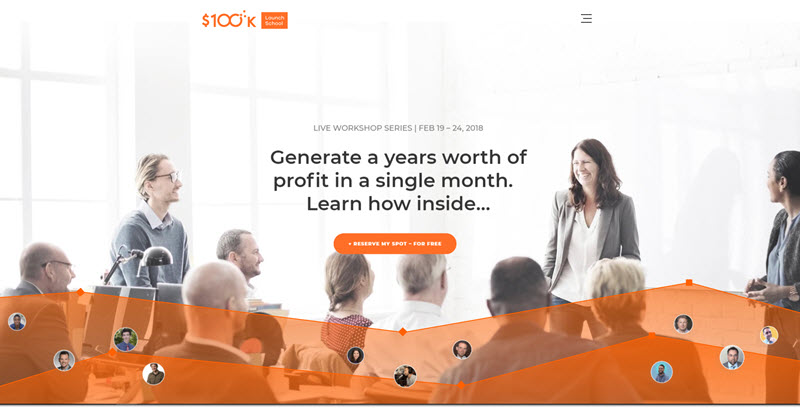
And here’s an example of what it looked like when personalized for freelancers:

Versus what it looked like when I personalized it for authors:
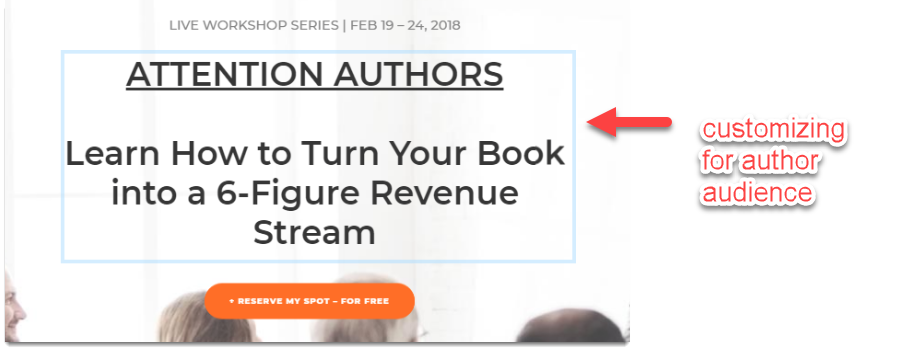
I did some additional tweaks to the landing page copy – here’s what it looked like for freelancers again:
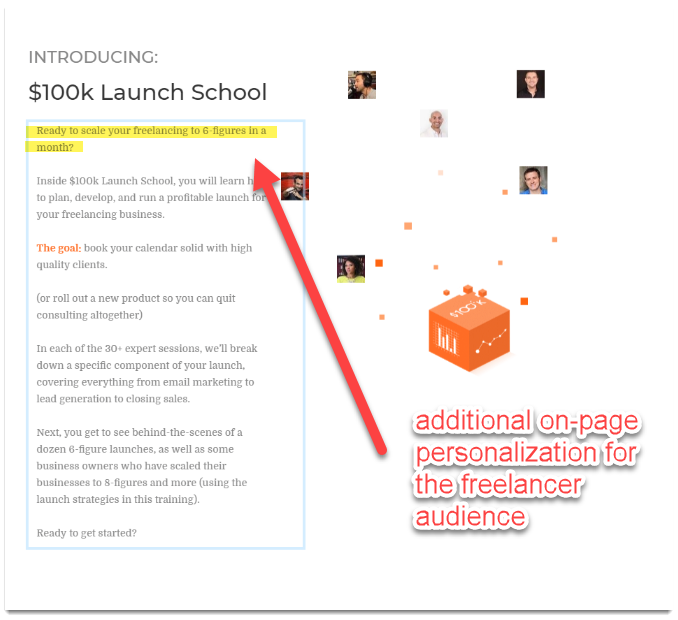
Personally, I saw a 47% lift in optin registrations (went from 46.9% to 68.9% optin on the main registration page).
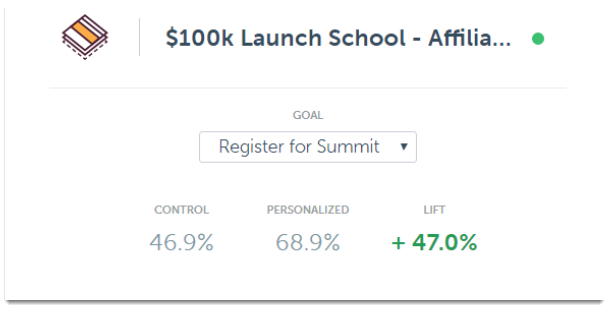
In the end, personalizing my registration page led led to another 619 subscribers, and generated another $2,185.07 in gross revenue (solely from “All Access Pass” sales).
Bottom line: I highly recommend customizing your registration and sales pages, no matter what sort of campaign you’re running. If you need help getting started, just email me and I can help coach you through it.
WRAPPING UP
There are a lot more things we could dive into when it comes to virtual summits, from securing sponsorship, to crafting your specific email sequence, to increasing subscribers with additional lead magnets and more – but I’m at over 13,000 words on this blog post, so I think it’s time to wrap this up.
So let me know in the comments:
Are you planning to run a virtual summit? Why or why not?
And what additional questions do you have about creating your virtual summit? If I could expand on certain subjects or topics, what would you like to hear about?
Share in the comments below. I’d love to hear from you!
Reference: The article contents are originally written at and sourced from https://tommorkes.com/virtual-summit/. We don’t express/any claim to the ownership. If you have any concerns, please contact our editorial team.


